Intercultural Management in Business
VerifiedAdded on 2022/12/29
|10
|2577
|77
Case Study
AI Summary
This case study examines the challenges faced by John Smith, a chief engineer, in managing a culturally diverse team of Japanese trainees. It highlights the importance of understanding intercultural dynamics and offers strategies for improving communication, motivation, and team cohesion. The report discusses various intercultural theories and management styles that can help John navigate the complexities of cross-cultural interactions, ultimately leading to better business outcomes.
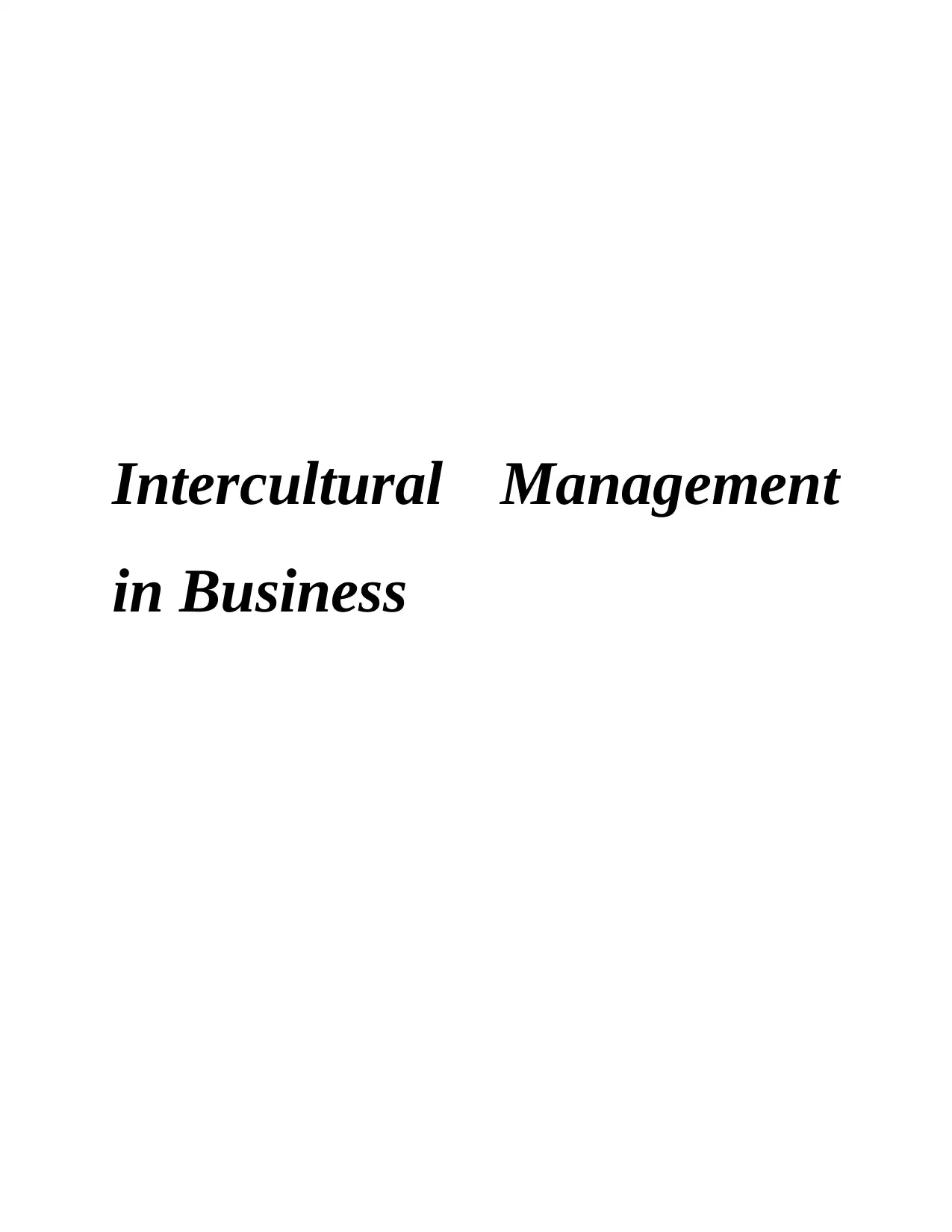
Intercultural Management
in Business
in Business
Paraphrase This Document
Need a fresh take? Get an instant paraphrase of this document with our AI Paraphraser
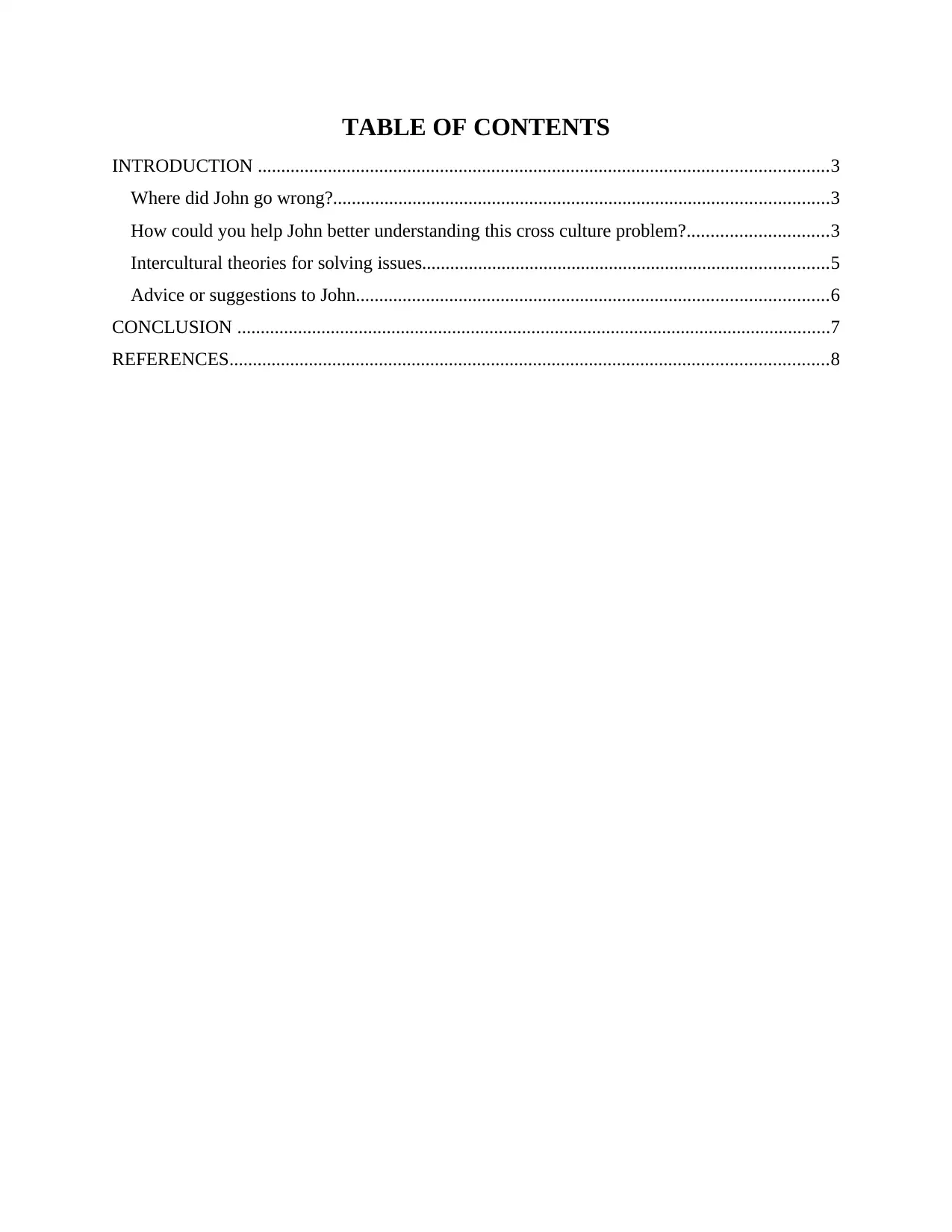
TABLE OF CONTENTS
INTRODUCTION ..........................................................................................................................3
Where did John go wrong?..........................................................................................................3
How could you help John better understanding this cross culture problem?..............................3
Intercultural theories for solving issues.......................................................................................5
Advice or suggestions to John.....................................................................................................6
CONCLUSION ...............................................................................................................................7
REFERENCES................................................................................................................................8
INTRODUCTION ..........................................................................................................................3
Where did John go wrong?..........................................................................................................3
How could you help John better understanding this cross culture problem?..............................3
Intercultural theories for solving issues.......................................................................................5
Advice or suggestions to John.....................................................................................................6
CONCLUSION ...............................................................................................................................7
REFERENCES................................................................................................................................8

⊘ This is a preview!⊘
Do you want full access?
Subscribe today to unlock all pages.

Trusted by 1+ million students worldwide
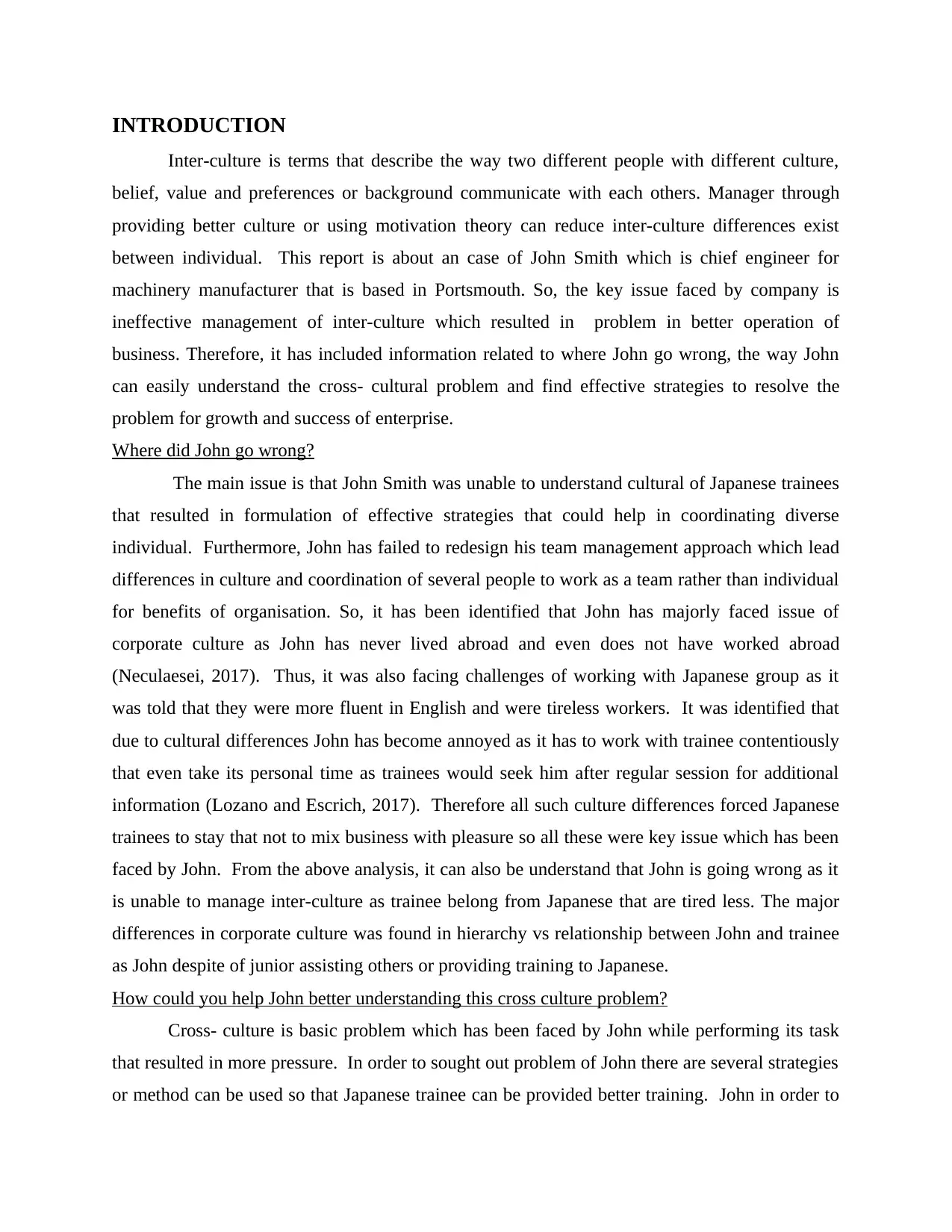
INTRODUCTION
Inter-culture is terms that describe the way two different people with different culture,
belief, value and preferences or background communicate with each others. Manager through
providing better culture or using motivation theory can reduce inter-culture differences exist
between individual. This report is about an case of John Smith which is chief engineer for
machinery manufacturer that is based in Portsmouth. So, the key issue faced by company is
ineffective management of inter-culture which resulted in problem in better operation of
business. Therefore, it has included information related to where John go wrong, the way John
can easily understand the cross- cultural problem and find effective strategies to resolve the
problem for growth and success of enterprise.
Where did John go wrong?
The main issue is that John Smith was unable to understand cultural of Japanese trainees
that resulted in formulation of effective strategies that could help in coordinating diverse
individual. Furthermore, John has failed to redesign his team management approach which lead
differences in culture and coordination of several people to work as a team rather than individual
for benefits of organisation. So, it has been identified that John has majorly faced issue of
corporate culture as John has never lived abroad and even does not have worked abroad
(Neculaesei, 2017). Thus, it was also facing challenges of working with Japanese group as it
was told that they were more fluent in English and were tireless workers. It was identified that
due to cultural differences John has become annoyed as it has to work with trainee contentiously
that even take its personal time as trainees would seek him after regular session for additional
information (Lozano and Escrich, 2017). Therefore all such culture differences forced Japanese
trainees to stay that not to mix business with pleasure so all these were key issue which has been
faced by John. From the above analysis, it can also be understand that John is going wrong as it
is unable to manage inter-culture as trainee belong from Japanese that are tired less. The major
differences in corporate culture was found in hierarchy vs relationship between John and trainee
as John despite of junior assisting others or providing training to Japanese.
How could you help John better understanding this cross culture problem?
Cross- culture is basic problem which has been faced by John while performing its task
that resulted in more pressure. In order to sought out problem of John there are several strategies
or method can be used so that Japanese trainee can be provided better training. John in order to
Inter-culture is terms that describe the way two different people with different culture,
belief, value and preferences or background communicate with each others. Manager through
providing better culture or using motivation theory can reduce inter-culture differences exist
between individual. This report is about an case of John Smith which is chief engineer for
machinery manufacturer that is based in Portsmouth. So, the key issue faced by company is
ineffective management of inter-culture which resulted in problem in better operation of
business. Therefore, it has included information related to where John go wrong, the way John
can easily understand the cross- cultural problem and find effective strategies to resolve the
problem for growth and success of enterprise.
Where did John go wrong?
The main issue is that John Smith was unable to understand cultural of Japanese trainees
that resulted in formulation of effective strategies that could help in coordinating diverse
individual. Furthermore, John has failed to redesign his team management approach which lead
differences in culture and coordination of several people to work as a team rather than individual
for benefits of organisation. So, it has been identified that John has majorly faced issue of
corporate culture as John has never lived abroad and even does not have worked abroad
(Neculaesei, 2017). Thus, it was also facing challenges of working with Japanese group as it
was told that they were more fluent in English and were tireless workers. It was identified that
due to cultural differences John has become annoyed as it has to work with trainee contentiously
that even take its personal time as trainees would seek him after regular session for additional
information (Lozano and Escrich, 2017). Therefore all such culture differences forced Japanese
trainees to stay that not to mix business with pleasure so all these were key issue which has been
faced by John. From the above analysis, it can also be understand that John is going wrong as it
is unable to manage inter-culture as trainee belong from Japanese that are tired less. The major
differences in corporate culture was found in hierarchy vs relationship between John and trainee
as John despite of junior assisting others or providing training to Japanese.
How could you help John better understanding this cross culture problem?
Cross- culture is basic problem which has been faced by John while performing its task
that resulted in more pressure. In order to sought out problem of John there are several strategies
or method can be used so that Japanese trainee can be provided better training. John in order to
Paraphrase This Document
Need a fresh take? Get an instant paraphrase of this document with our AI Paraphraser
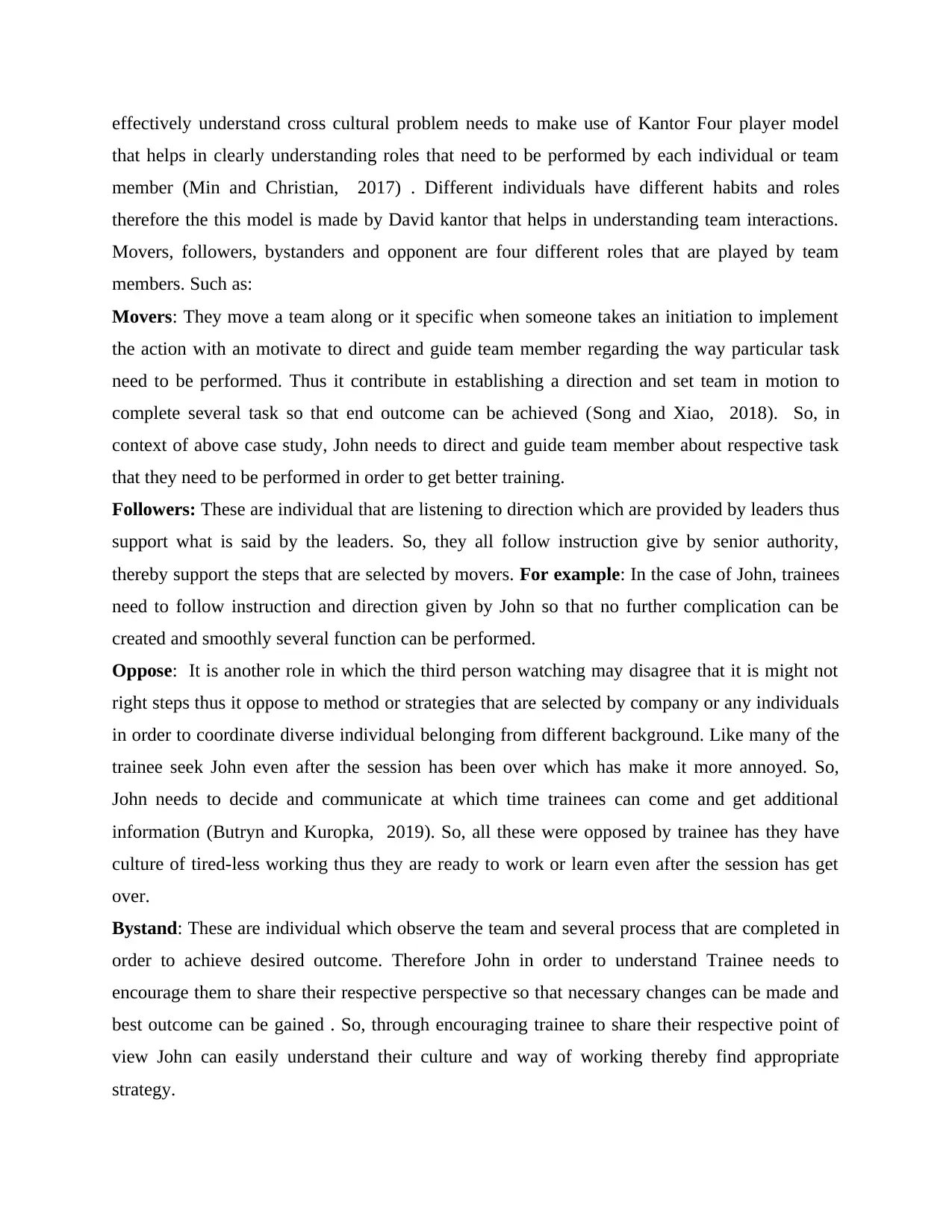
effectively understand cross cultural problem needs to make use of Kantor Four player model
that helps in clearly understanding roles that need to be performed by each individual or team
member (Min and Christian, 2017) . Different individuals have different habits and roles
therefore the this model is made by David kantor that helps in understanding team interactions.
Movers, followers, bystanders and opponent are four different roles that are played by team
members. Such as:
Movers: They move a team along or it specific when someone takes an initiation to implement
the action with an motivate to direct and guide team member regarding the way particular task
need to be performed. Thus it contribute in establishing a direction and set team in motion to
complete several task so that end outcome can be achieved (Song and Xiao, 2018). So, in
context of above case study, John needs to direct and guide team member about respective task
that they need to be performed in order to get better training.
Followers: These are individual that are listening to direction which are provided by leaders thus
support what is said by the leaders. So, they all follow instruction give by senior authority,
thereby support the steps that are selected by movers. For example: In the case of John, trainees
need to follow instruction and direction given by John so that no further complication can be
created and smoothly several function can be performed.
Oppose: It is another role in which the third person watching may disagree that it is might not
right steps thus it oppose to method or strategies that are selected by company or any individuals
in order to coordinate diverse individual belonging from different background. Like many of the
trainee seek John even after the session has been over which has make it more annoyed. So,
John needs to decide and communicate at which time trainees can come and get additional
information (Butryn and Kuropka, 2019). So, all these were opposed by trainee has they have
culture of tired-less working thus they are ready to work or learn even after the session has get
over.
Bystand: These are individual which observe the team and several process that are completed in
order to achieve desired outcome. Therefore John in order to understand Trainee needs to
encourage them to share their respective perspective so that necessary changes can be made and
best outcome can be gained . So, through encouraging trainee to share their respective point of
view John can easily understand their culture and way of working thereby find appropriate
strategy.
that helps in clearly understanding roles that need to be performed by each individual or team
member (Min and Christian, 2017) . Different individuals have different habits and roles
therefore the this model is made by David kantor that helps in understanding team interactions.
Movers, followers, bystanders and opponent are four different roles that are played by team
members. Such as:
Movers: They move a team along or it specific when someone takes an initiation to implement
the action with an motivate to direct and guide team member regarding the way particular task
need to be performed. Thus it contribute in establishing a direction and set team in motion to
complete several task so that end outcome can be achieved (Song and Xiao, 2018). So, in
context of above case study, John needs to direct and guide team member about respective task
that they need to be performed in order to get better training.
Followers: These are individual that are listening to direction which are provided by leaders thus
support what is said by the leaders. So, they all follow instruction give by senior authority,
thereby support the steps that are selected by movers. For example: In the case of John, trainees
need to follow instruction and direction given by John so that no further complication can be
created and smoothly several function can be performed.
Oppose: It is another role in which the third person watching may disagree that it is might not
right steps thus it oppose to method or strategies that are selected by company or any individuals
in order to coordinate diverse individual belonging from different background. Like many of the
trainee seek John even after the session has been over which has make it more annoyed. So,
John needs to decide and communicate at which time trainees can come and get additional
information (Butryn and Kuropka, 2019). So, all these were opposed by trainee has they have
culture of tired-less working thus they are ready to work or learn even after the session has get
over.
Bystand: These are individual which observe the team and several process that are completed in
order to achieve desired outcome. Therefore John in order to understand Trainee needs to
encourage them to share their respective perspective so that necessary changes can be made and
best outcome can be gained . So, through encouraging trainee to share their respective point of
view John can easily understand their culture and way of working thereby find appropriate
strategy.
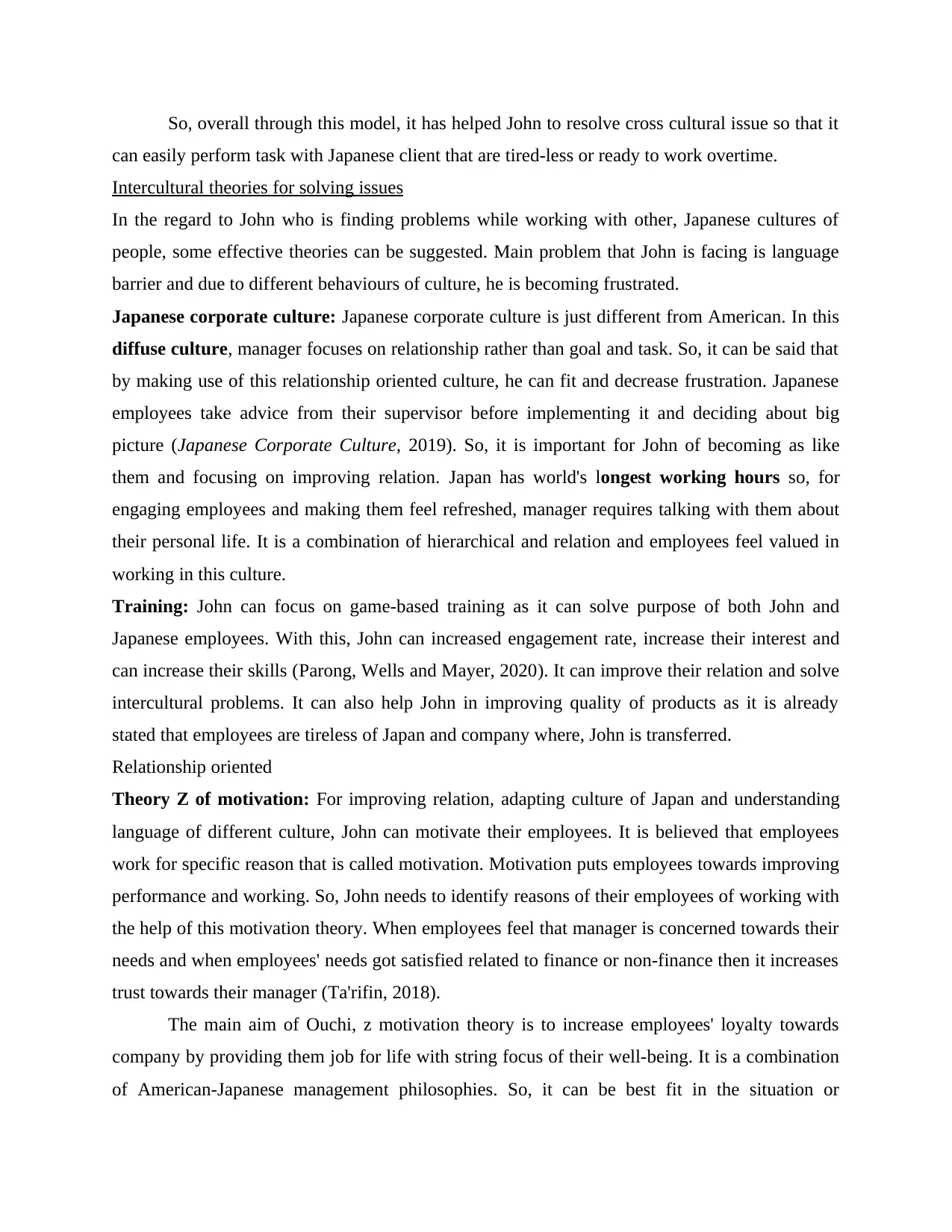
So, overall through this model, it has helped John to resolve cross cultural issue so that it
can easily perform task with Japanese client that are tired-less or ready to work overtime.
Intercultural theories for solving issues
In the regard to John who is finding problems while working with other, Japanese cultures of
people, some effective theories can be suggested. Main problem that John is facing is language
barrier and due to different behaviours of culture, he is becoming frustrated.
Japanese corporate culture: Japanese corporate culture is just different from American. In this
diffuse culture, manager focuses on relationship rather than goal and task. So, it can be said that
by making use of this relationship oriented culture, he can fit and decrease frustration. Japanese
employees take advice from their supervisor before implementing it and deciding about big
picture (Japanese Corporate Culture, 2019). So, it is important for John of becoming as like
them and focusing on improving relation. Japan has world's longest working hours so, for
engaging employees and making them feel refreshed, manager requires talking with them about
their personal life. It is a combination of hierarchical and relation and employees feel valued in
working in this culture.
Training: John can focus on game-based training as it can solve purpose of both John and
Japanese employees. With this, John can increased engagement rate, increase their interest and
can increase their skills (Parong, Wells and Mayer, 2020). It can improve their relation and solve
intercultural problems. It can also help John in improving quality of products as it is already
stated that employees are tireless of Japan and company where, John is transferred.
Relationship oriented
Theory Z of motivation: For improving relation, adapting culture of Japan and understanding
language of different culture, John can motivate their employees. It is believed that employees
work for specific reason that is called motivation. Motivation puts employees towards improving
performance and working. So, John needs to identify reasons of their employees of working with
the help of this motivation theory. When employees feel that manager is concerned towards their
needs and when employees' needs got satisfied related to finance or non-finance then it increases
trust towards their manager (Ta'rifin, 2018).
The main aim of Ouchi, z motivation theory is to increase employees' loyalty towards
company by providing them job for life with string focus of their well-being. It is a combination
of American-Japanese management philosophies. So, it can be best fit in the situation or
can easily perform task with Japanese client that are tired-less or ready to work overtime.
Intercultural theories for solving issues
In the regard to John who is finding problems while working with other, Japanese cultures of
people, some effective theories can be suggested. Main problem that John is facing is language
barrier and due to different behaviours of culture, he is becoming frustrated.
Japanese corporate culture: Japanese corporate culture is just different from American. In this
diffuse culture, manager focuses on relationship rather than goal and task. So, it can be said that
by making use of this relationship oriented culture, he can fit and decrease frustration. Japanese
employees take advice from their supervisor before implementing it and deciding about big
picture (Japanese Corporate Culture, 2019). So, it is important for John of becoming as like
them and focusing on improving relation. Japan has world's longest working hours so, for
engaging employees and making them feel refreshed, manager requires talking with them about
their personal life. It is a combination of hierarchical and relation and employees feel valued in
working in this culture.
Training: John can focus on game-based training as it can solve purpose of both John and
Japanese employees. With this, John can increased engagement rate, increase their interest and
can increase their skills (Parong, Wells and Mayer, 2020). It can improve their relation and solve
intercultural problems. It can also help John in improving quality of products as it is already
stated that employees are tireless of Japan and company where, John is transferred.
Relationship oriented
Theory Z of motivation: For improving relation, adapting culture of Japan and understanding
language of different culture, John can motivate their employees. It is believed that employees
work for specific reason that is called motivation. Motivation puts employees towards improving
performance and working. So, John needs to identify reasons of their employees of working with
the help of this motivation theory. When employees feel that manager is concerned towards their
needs and when employees' needs got satisfied related to finance or non-finance then it increases
trust towards their manager (Ta'rifin, 2018).
The main aim of Ouchi, z motivation theory is to increase employees' loyalty towards
company by providing them job for life with string focus of their well-being. It is a combination
of American-Japanese management philosophies. So, it can be best fit in the situation or
⊘ This is a preview!⊘
Do you want full access?
Subscribe today to unlock all pages.

Trusted by 1+ million students worldwide
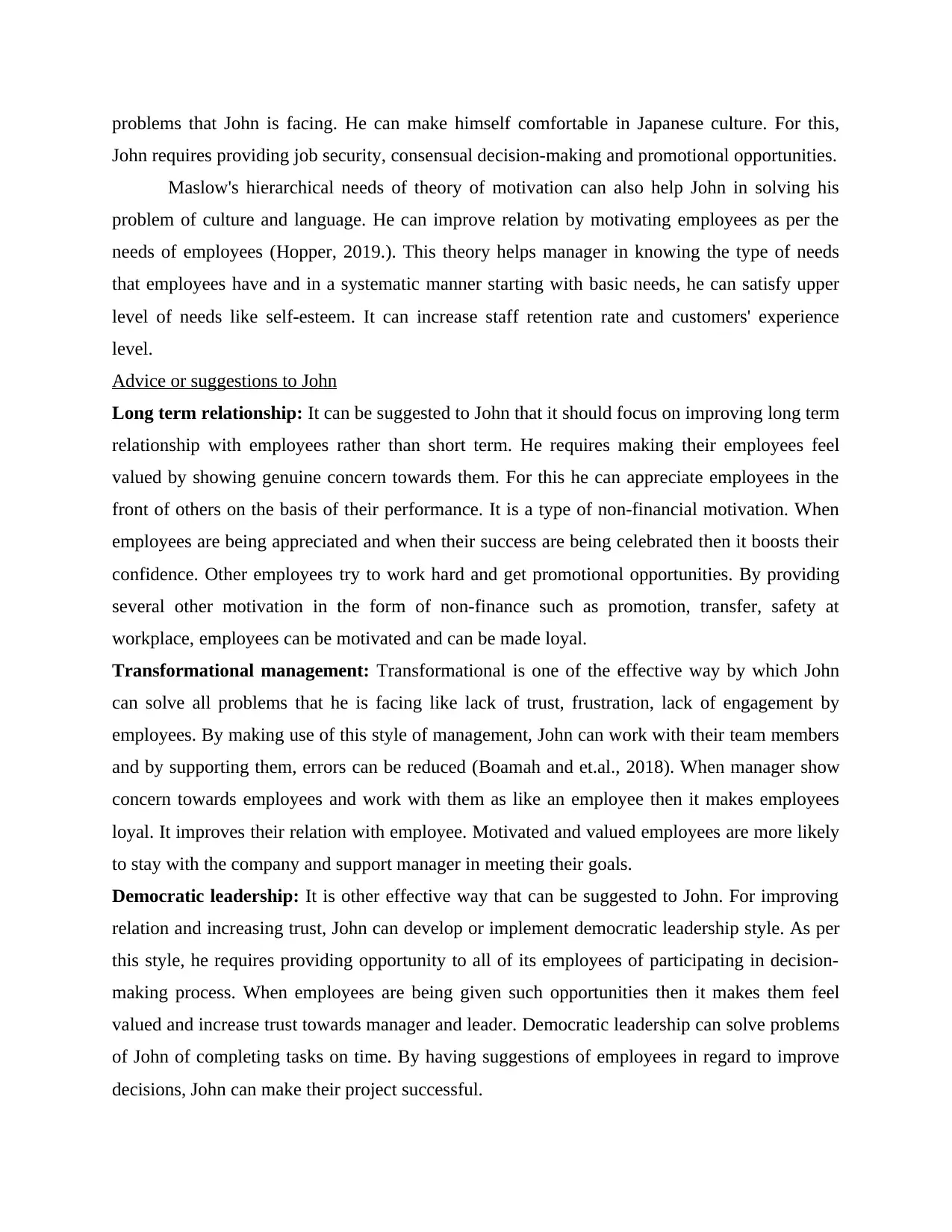
problems that John is facing. He can make himself comfortable in Japanese culture. For this,
John requires providing job security, consensual decision-making and promotional opportunities.
Maslow's hierarchical needs of theory of motivation can also help John in solving his
problem of culture and language. He can improve relation by motivating employees as per the
needs of employees (Hopper, 2019.). This theory helps manager in knowing the type of needs
that employees have and in a systematic manner starting with basic needs, he can satisfy upper
level of needs like self-esteem. It can increase staff retention rate and customers' experience
level.
Advice or suggestions to John
Long term relationship: It can be suggested to John that it should focus on improving long term
relationship with employees rather than short term. He requires making their employees feel
valued by showing genuine concern towards them. For this he can appreciate employees in the
front of others on the basis of their performance. It is a type of non-financial motivation. When
employees are being appreciated and when their success are being celebrated then it boosts their
confidence. Other employees try to work hard and get promotional opportunities. By providing
several other motivation in the form of non-finance such as promotion, transfer, safety at
workplace, employees can be motivated and can be made loyal.
Transformational management: Transformational is one of the effective way by which John
can solve all problems that he is facing like lack of trust, frustration, lack of engagement by
employees. By making use of this style of management, John can work with their team members
and by supporting them, errors can be reduced (Boamah and et.al., 2018). When manager show
concern towards employees and work with them as like an employee then it makes employees
loyal. It improves their relation with employee. Motivated and valued employees are more likely
to stay with the company and support manager in meeting their goals.
Democratic leadership: It is other effective way that can be suggested to John. For improving
relation and increasing trust, John can develop or implement democratic leadership style. As per
this style, he requires providing opportunity to all of its employees of participating in decision-
making process. When employees are being given such opportunities then it makes them feel
valued and increase trust towards manager and leader. Democratic leadership can solve problems
of John of completing tasks on time. By having suggestions of employees in regard to improve
decisions, John can make their project successful.
John requires providing job security, consensual decision-making and promotional opportunities.
Maslow's hierarchical needs of theory of motivation can also help John in solving his
problem of culture and language. He can improve relation by motivating employees as per the
needs of employees (Hopper, 2019.). This theory helps manager in knowing the type of needs
that employees have and in a systematic manner starting with basic needs, he can satisfy upper
level of needs like self-esteem. It can increase staff retention rate and customers' experience
level.
Advice or suggestions to John
Long term relationship: It can be suggested to John that it should focus on improving long term
relationship with employees rather than short term. He requires making their employees feel
valued by showing genuine concern towards them. For this he can appreciate employees in the
front of others on the basis of their performance. It is a type of non-financial motivation. When
employees are being appreciated and when their success are being celebrated then it boosts their
confidence. Other employees try to work hard and get promotional opportunities. By providing
several other motivation in the form of non-finance such as promotion, transfer, safety at
workplace, employees can be motivated and can be made loyal.
Transformational management: Transformational is one of the effective way by which John
can solve all problems that he is facing like lack of trust, frustration, lack of engagement by
employees. By making use of this style of management, John can work with their team members
and by supporting them, errors can be reduced (Boamah and et.al., 2018). When manager show
concern towards employees and work with them as like an employee then it makes employees
loyal. It improves their relation with employee. Motivated and valued employees are more likely
to stay with the company and support manager in meeting their goals.
Democratic leadership: It is other effective way that can be suggested to John. For improving
relation and increasing trust, John can develop or implement democratic leadership style. As per
this style, he requires providing opportunity to all of its employees of participating in decision-
making process. When employees are being given such opportunities then it makes them feel
valued and increase trust towards manager and leader. Democratic leadership can solve problems
of John of completing tasks on time. By having suggestions of employees in regard to improve
decisions, John can make their project successful.
Paraphrase This Document
Need a fresh take? Get an instant paraphrase of this document with our AI Paraphraser
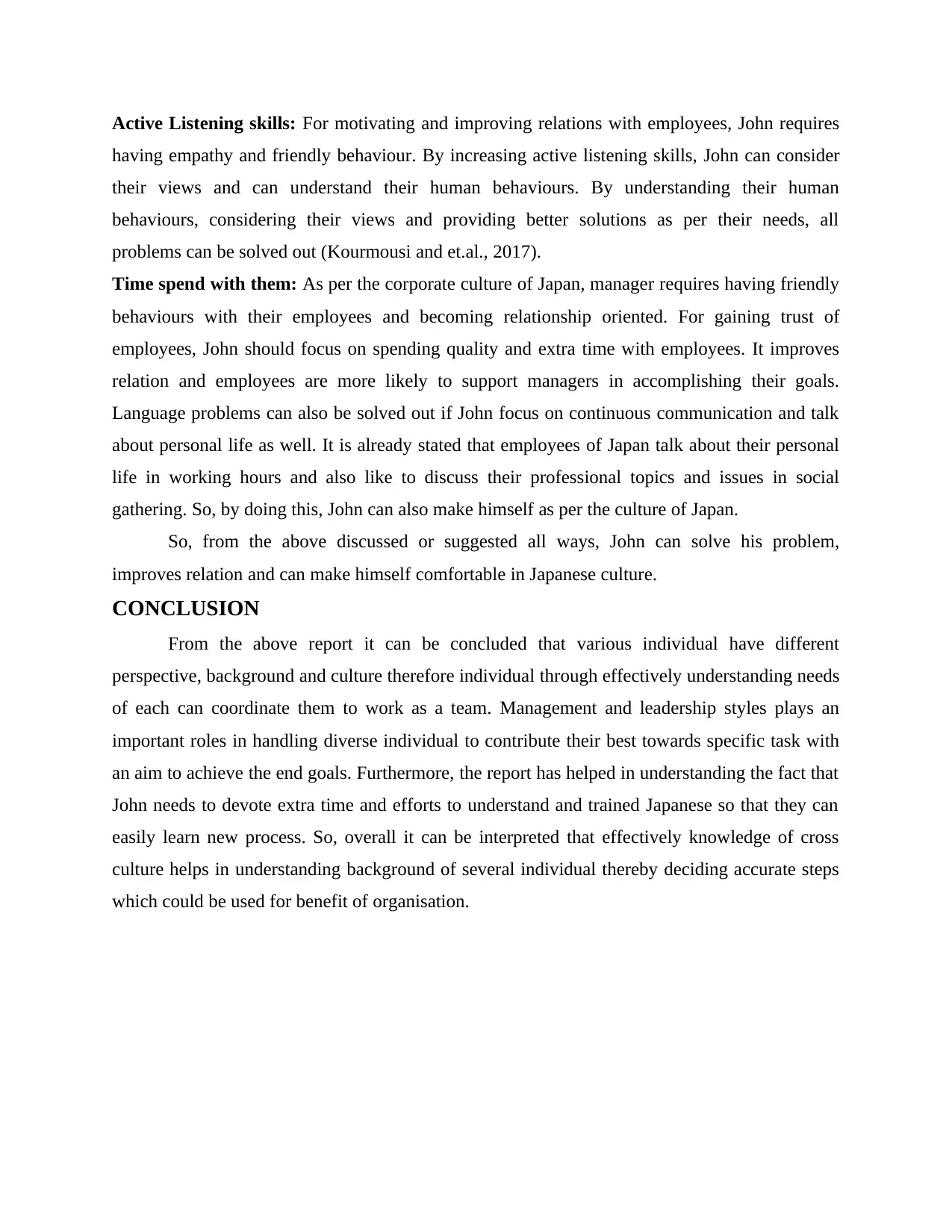
Active Listening skills: For motivating and improving relations with employees, John requires
having empathy and friendly behaviour. By increasing active listening skills, John can consider
their views and can understand their human behaviours. By understanding their human
behaviours, considering their views and providing better solutions as per their needs, all
problems can be solved out (Kourmousi and et.al., 2017).
Time spend with them: As per the corporate culture of Japan, manager requires having friendly
behaviours with their employees and becoming relationship oriented. For gaining trust of
employees, John should focus on spending quality and extra time with employees. It improves
relation and employees are more likely to support managers in accomplishing their goals.
Language problems can also be solved out if John focus on continuous communication and talk
about personal life as well. It is already stated that employees of Japan talk about their personal
life in working hours and also like to discuss their professional topics and issues in social
gathering. So, by doing this, John can also make himself as per the culture of Japan.
So, from the above discussed or suggested all ways, John can solve his problem,
improves relation and can make himself comfortable in Japanese culture.
CONCLUSION
From the above report it can be concluded that various individual have different
perspective, background and culture therefore individual through effectively understanding needs
of each can coordinate them to work as a team. Management and leadership styles plays an
important roles in handling diverse individual to contribute their best towards specific task with
an aim to achieve the end goals. Furthermore, the report has helped in understanding the fact that
John needs to devote extra time and efforts to understand and trained Japanese so that they can
easily learn new process. So, overall it can be interpreted that effectively knowledge of cross
culture helps in understanding background of several individual thereby deciding accurate steps
which could be used for benefit of organisation.
having empathy and friendly behaviour. By increasing active listening skills, John can consider
their views and can understand their human behaviours. By understanding their human
behaviours, considering their views and providing better solutions as per their needs, all
problems can be solved out (Kourmousi and et.al., 2017).
Time spend with them: As per the corporate culture of Japan, manager requires having friendly
behaviours with their employees and becoming relationship oriented. For gaining trust of
employees, John should focus on spending quality and extra time with employees. It improves
relation and employees are more likely to support managers in accomplishing their goals.
Language problems can also be solved out if John focus on continuous communication and talk
about personal life as well. It is already stated that employees of Japan talk about their personal
life in working hours and also like to discuss their professional topics and issues in social
gathering. So, by doing this, John can also make himself as per the culture of Japan.
So, from the above discussed or suggested all ways, John can solve his problem,
improves relation and can make himself comfortable in Japanese culture.
CONCLUSION
From the above report it can be concluded that various individual have different
perspective, background and culture therefore individual through effectively understanding needs
of each can coordinate them to work as a team. Management and leadership styles plays an
important roles in handling diverse individual to contribute their best towards specific task with
an aim to achieve the end goals. Furthermore, the report has helped in understanding the fact that
John needs to devote extra time and efforts to understand and trained Japanese so that they can
easily learn new process. So, overall it can be interpreted that effectively knowledge of cross
culture helps in understanding background of several individual thereby deciding accurate steps
which could be used for benefit of organisation.
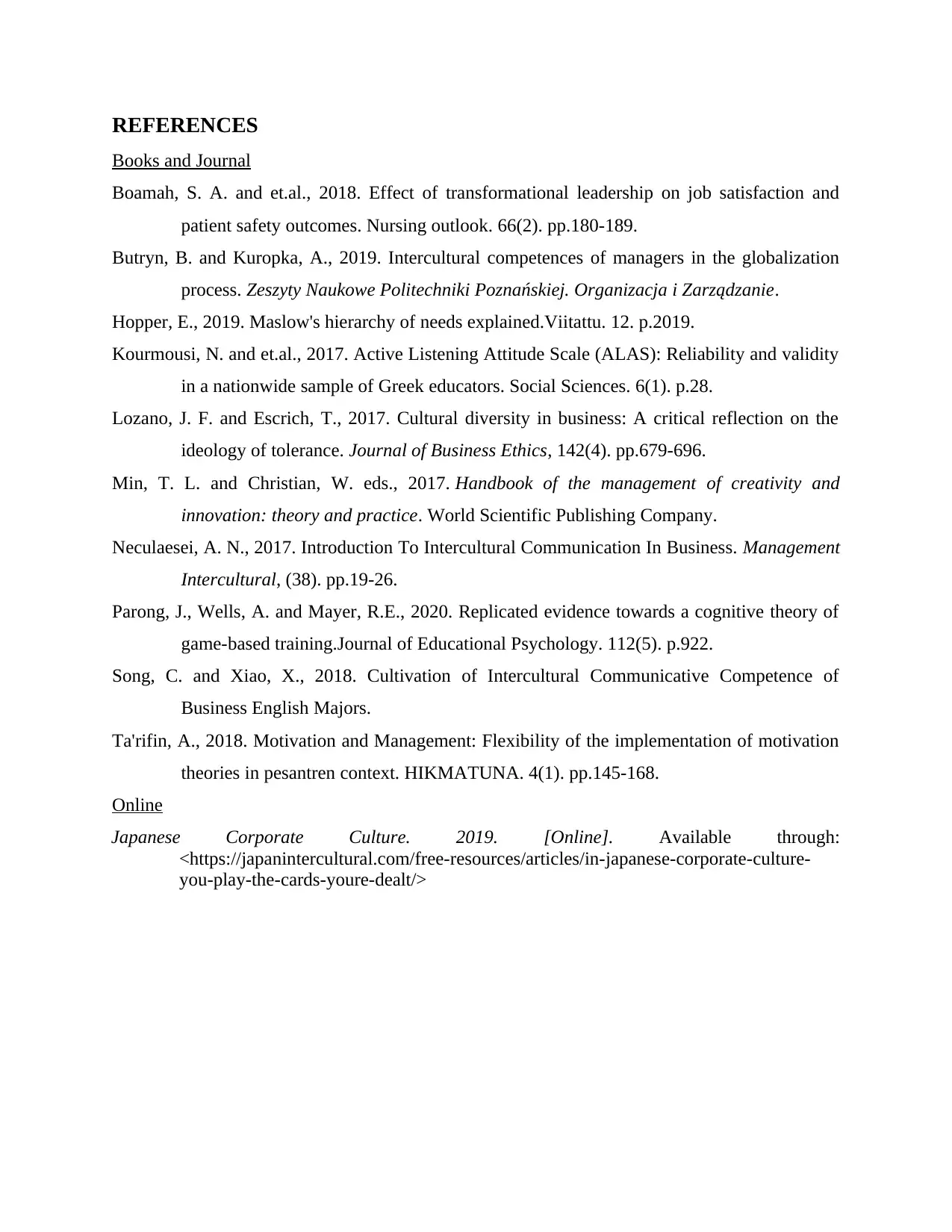
REFERENCES
Books and Journal
Boamah, S. A. and et.al., 2018. Effect of transformational leadership on job satisfaction and
patient safety outcomes. Nursing outlook. 66(2). pp.180-189.
Butryn, B. and Kuropka, A., 2019. Intercultural competences of managers in the globalization
process. Zeszyty Naukowe Politechniki Poznańskiej. Organizacja i Zarządzanie.
Hopper, E., 2019. Maslow's hierarchy of needs explained.Viitattu. 12. p.2019.
Kourmousi, N. and et.al., 2017. Active Listening Attitude Scale (ALAS): Reliability and validity
in a nationwide sample of Greek educators. Social Sciences. 6(1). p.28.
Lozano, J. F. and Escrich, T., 2017. Cultural diversity in business: A critical reflection on the
ideology of tolerance. Journal of Business Ethics, 142(4). pp.679-696.
Min, T. L. and Christian, W. eds., 2017. Handbook of the management of creativity and
innovation: theory and practice. World Scientific Publishing Company.
Neculaesei, A. N., 2017. Introduction To Intercultural Communication In Business. Management
Intercultural, (38). pp.19-26.
Parong, J., Wells, A. and Mayer, R.E., 2020. Replicated evidence towards a cognitive theory of
game-based training.Journal of Educational Psychology. 112(5). p.922.
Song, C. and Xiao, X., 2018. Cultivation of Intercultural Communicative Competence of
Business English Majors.
Ta'rifin, A., 2018. Motivation and Management: Flexibility of the implementation of motivation
theories in pesantren context. HIKMATUNA. 4(1). pp.145-168.
Online
Japanese Corporate Culture. 2019. [Online]. Available through:
<https://japanintercultural.com/free-resources/articles/in-japanese-corporate-culture-
you-play-the-cards-youre-dealt/>
Books and Journal
Boamah, S. A. and et.al., 2018. Effect of transformational leadership on job satisfaction and
patient safety outcomes. Nursing outlook. 66(2). pp.180-189.
Butryn, B. and Kuropka, A., 2019. Intercultural competences of managers in the globalization
process. Zeszyty Naukowe Politechniki Poznańskiej. Organizacja i Zarządzanie.
Hopper, E., 2019. Maslow's hierarchy of needs explained.Viitattu. 12. p.2019.
Kourmousi, N. and et.al., 2017. Active Listening Attitude Scale (ALAS): Reliability and validity
in a nationwide sample of Greek educators. Social Sciences. 6(1). p.28.
Lozano, J. F. and Escrich, T., 2017. Cultural diversity in business: A critical reflection on the
ideology of tolerance. Journal of Business Ethics, 142(4). pp.679-696.
Min, T. L. and Christian, W. eds., 2017. Handbook of the management of creativity and
innovation: theory and practice. World Scientific Publishing Company.
Neculaesei, A. N., 2017. Introduction To Intercultural Communication In Business. Management
Intercultural, (38). pp.19-26.
Parong, J., Wells, A. and Mayer, R.E., 2020. Replicated evidence towards a cognitive theory of
game-based training.Journal of Educational Psychology. 112(5). p.922.
Song, C. and Xiao, X., 2018. Cultivation of Intercultural Communicative Competence of
Business English Majors.
Ta'rifin, A., 2018. Motivation and Management: Flexibility of the implementation of motivation
theories in pesantren context. HIKMATUNA. 4(1). pp.145-168.
Online
Japanese Corporate Culture. 2019. [Online]. Available through:
<https://japanintercultural.com/free-resources/articles/in-japanese-corporate-culture-
you-play-the-cards-youre-dealt/>
⊘ This is a preview!⊘
Do you want full access?
Subscribe today to unlock all pages.

Trusted by 1+ million students worldwide

1 out of 10
Related Documents
Your All-in-One AI-Powered Toolkit for Academic Success.
+13062052269
info@desklib.com
Available 24*7 on WhatsApp / Email
![[object Object]](/_next/static/media/star-bottom.7253800d.svg)
Unlock your academic potential
Copyright © 2020–2025 A2Z Services. All Rights Reserved. Developed and managed by ZUCOL.




